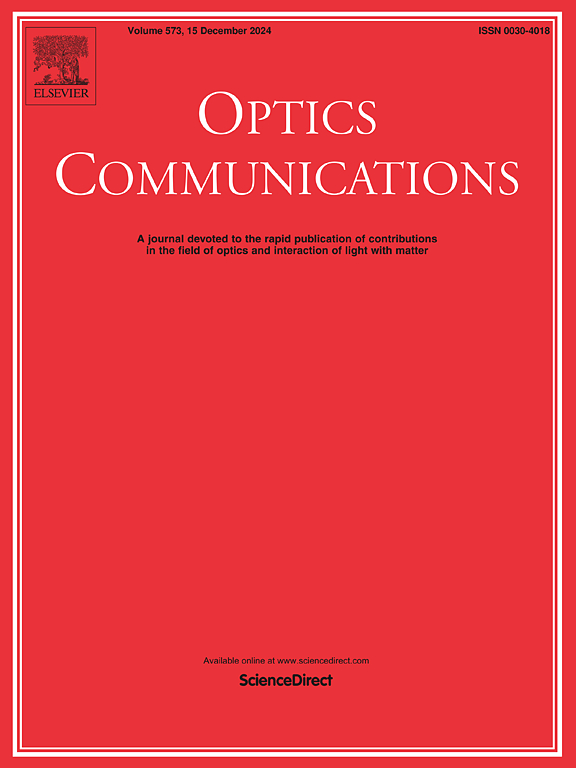Temperature compensated optical fiber current sensing system based on a two-tap microwave photonic filter
IF 2.5
3区 物理与天体物理
Q2 OPTICS
引用次数: 0
Abstract
In this paper, a two-tap microwave photonic filter (MPF) based temperature compensated optical fiber current sensing system has been proposed and experimentally demonstrated. Two fiber Bragg gratings (FBGs) are employed in the experiment, and the light signals modulated by radio-frequency (RF) signals reflected by two FBGs can be treated as two tap signals, which enter the dispersion-compensated fiber for the delay and beat through the photodetector to recover the RF signals, then a two-tap MPF is formed. Two FBGs are considered as the sensing and temperature compensation elements, respectively. The sensing FBG is affixed on the Terfenol-D. The variation of the current applied to the solenoid changes the magnetic field, and axial stretching strain is generated on the sensing element and sensing FBG's wavelength will change, which results in the shifts of the dip frequency of the MPF, by measuring which the current can be demodulated. Meanwhile, applying current will cause internal heating of the solenoid, and to further reduce the effect of the variation of temperature on current measurement, the temperature compensation FBG is affixed on the temperature compensated material Monel-400, and both two FBGs are placed inside the solenoid and good temperature compensation can be obtained. In the three-time repetitive continuous experiment, the current sensitivity as current increases of the system with temperature compensation is 4.23 MHz/A. The current measurement errors of the systems without and with temperature compensation are 0.83 A and 0.12 A, respectively. Our proposed system offers the advantages of easy fabrication, high current resolution with temperature compensation, good repeatability and high system stability, high current measurement precision, etc.
基于双抽头微波光子滤波器的温度补偿光纤电流传感系统
本文提出了一种基于双抽头微波光子滤波器的温度补偿光纤电流传感系统,并进行了实验验证。实验采用两个光纤布拉格光栅(fbg),将两个光纤光栅反射的射频信号调制后的光信号作为两个抽头信号处理,通过光电探测器进入色散补偿光纤中进行延时和拍频,恢复射频信号,形成一个双抽头MPF。两个fbg分别作为传感元件和温度补偿元件。传感光纤光栅贴在Terfenol-D上。施加在螺线管上的电流的变化会改变磁场,在传感元件上产生轴向拉伸应变,传感FBG的波长会发生变化,从而导致MPF的倾角频率发生位移,通过测量该频率可以解调电流。同时,施加电流会引起螺线管内部发热,为了进一步降低温度变化对电流测量的影响,将温度补偿FBG贴在温度补偿材料Monel-400上,两个FBG都放置在螺线管内部,可以获得良好的温度补偿。在三次重复连续实验中,温度补偿系统随电流增大的电流灵敏度为4.23 MHz/A。无温度补偿和有温度补偿的系统电流测量误差分别为0.83 A和0.12 A。该系统具有制作简单、具有温度补偿的高电流分辨率、重复性好、系统稳定性好、电流测量精度高等优点。
本文章由计算机程序翻译,如有差异,请以英文原文为准。
求助全文
约1分钟内获得全文
求助全文
来源期刊

Optics Communications
物理-光学
CiteScore
5.10
自引率
8.30%
发文量
681
审稿时长
38 days
期刊介绍:
Optics Communications invites original and timely contributions containing new results in various fields of optics and photonics. The journal considers theoretical and experimental research in areas ranging from the fundamental properties of light to technological applications. Topics covered include classical and quantum optics, optical physics and light-matter interactions, lasers, imaging, guided-wave optics and optical information processing. Manuscripts should offer clear evidence of novelty and significance. Papers concentrating on mathematical and computational issues, with limited connection to optics, are not suitable for publication in the Journal. Similarly, small technical advances, or papers concerned only with engineering applications or issues of materials science fall outside the journal scope.
 求助内容:
求助内容: 应助结果提醒方式:
应助结果提醒方式:


